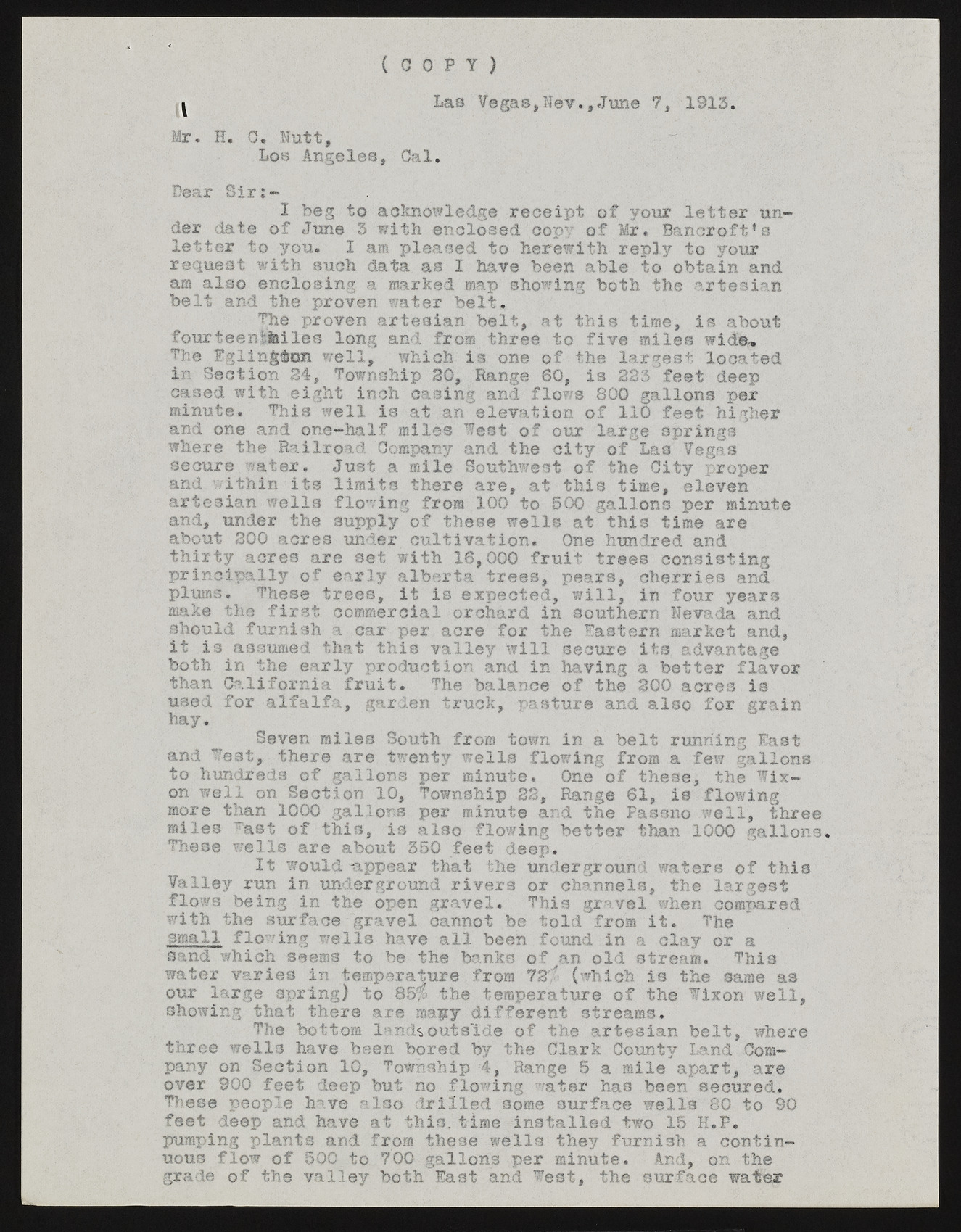Copyright & Fair-use Agreement
UNLV Special Collections provides copies of materials to facilitate private study, scholarship, or research. Material not in the public domain may be used according to fair use of copyrighted materials as defined by copyright law. Please cite us.
Please note that UNLV may not own the copyright to these materials and cannot provide permission to publish or distribute materials when UNLV is not the copyright holder. The user is solely responsible for determining the copyright status of materials and obtaining permission to use material from the copyright holder and for determining whether any permissions relating to any other rights are necessary for the intended use, and for obtaining all required permissions beyond that allowed by fair use.
Read more about our reproduction and use policy.
I agree.Information
Digital ID
Permalink
Details
Member of
More Info
Rights
Digital Provenance
Publisher
Transcription
( C O P Y ) Mr. If? Nutt, Los Angeles, Cal. Dear Sir; - I beg to acknowledge receipt of your letter under date of June 3 with enclosed copy of Mr. Bancroft1s letter to you. I am pleased to herewith reply to your request with such data as I have been able to obtain and am also enclosing a marked map showing both the artesian belt and the proven water belt. The proven artesian belt, at this time, is about fourteentfciles long and from three to five miles wide-. The Egiin|$on well, which is one of the largest located in Section 24, Township 20, Range 60, is 223 feet deep cased with eight inch casing and flows 800 gallons per minute. This well is at an elevation of 110 feet higher and one and one-half miles lest of our large springs where the Railroad Company and the city of Las Vegas secure water. Just a mile Southwest of the City yroper and within its limits there are, at this time, eleven artesian wells flowing from 100 to 500 gallons per minute and, under the supply of these wells at this time are about 200 acres under cultivation. One hundred and thirty acres are set with 16,000 fruit trees consisting principally of early alberta trees, pears, cherries and plums. These trees, it is expected, will, in four years make the first commercial orchard in southern Nevada and should furnish a car per acre for the Eastern market and, it is assumed that this valley will secure its advantage both in the early production and in having a better flavor than California fruit. The balance of the 200 acres is used for alfalfa, garden truck, pasture and also for grain hay. Seven miles South from town in a belt running East and Test, there are twenty wells flowing from a few gallons to 'hundreds of gallons per minute. One of these, the fix- on well on Section 10, Township 22, Range 61, is flowing more than 1000 gallons per minute and the Pasono well, three miles ast of this, is also flowing better than 1000 gallons. These wells are about 350 feet deep. It would appear that the underground waters of this Valley run in underground rivers or channels, the largest flows being in the open gravel. This gravel when compared with the surface gravel cannot be told from it. The small flowing wells have all been found in a clay or a sand which seems to be the banks of an old stream. This water varies in temperature from 73ft (which is the same as our large spring) to 85$ the temperature of the Wixon well, showing that there are ma$ry different streams. The bottom lands outside of the artesian belt, where three wells have been bored by the Clark County Land Company on Section 10, Township 4, Range 5 a mile apart, are over 900 feet deep but no flowing water has been secured. These people have also drilled some surface wells 80 to 90 feet deep and have at this, time installed two 15 H.P. pimping plants and from these wells they furnish a continuous flow of 500 to 700 gallons per minute. &nd, on the grade of the valley both East and Test, the surface water »i Las Vegas,Nev., June 7, 1913.

